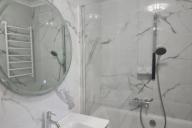To make your house look good, you can use just one type of flooring everywhere - but it's not always possible.
You can actually combine different types of flooring, but you should know how to do it correctly, so they won't clash.
Here are some tips that might help you find the right combination.
Consider the Flow
Think about how one room connects to another. Using similar flooring in connecting spaces creates a smooth and cohesive look.
Use Transition Pieces
When switching from one type of flooring to another, use transition strips.

These can be like bridges between different floors and help the transition look intentional.
Coordinate Colors
Choose flooring materials with colors that complement each other. This creates a harmonious feel between different types of flooring.
Think About Patterns
If one floor has a busy pattern, consider a simpler pattern or a solid color for the adjoining floor. This prevents the space from feeling too busy.
Match the Style
Stick to a similar style or theme. For example, if you have a modern look in one room, try to carry that style into the next with the flooring choice.
Use Area Rugs
Area rugs can be like magic decorators. They define spaces and help blend different flooring types. Plus, they add warmth and comfort.
Create Zones
Use different flooring to define specific zones within a large space. For example, use hardwood in the living area and tiles in the kitchen.
Balance Textures
If one floor is smooth, consider pairing it with a textured floor. This adds visual interest and variety.
Consider Maintenance
Think about the upkeep of different flooring materials. For areas prone to spills or moisture, choose materials that are easy to clean and maintain.
Get Samples
Before making a final decision, get samples of the flooring materials you're considering. See how they look in your space and how they work together.








